ThinkPad
 | |
 Lenovo ThinkPad X1 Carbon | |
| Developer |
IBM (1992-2005) Lenovo (2005-present) |
|---|---|
| Type | Laptop |
ThinkPad is a line of laptop computers and tablets by Lenovo. The series was designed, developed, and sold by IBM until Lenovo acquired the brand in 2005. ThinkPads are known for their minimalist, black and box design which was initially modeled in 1990 by industrial designer Richard Sapper based on the concept of a traditional Japanese Bento lunchbox revealing its nature only after being opened. According to later interviews with Sapper, he also characterized the simple ThinkPad form to be as elementary as a simple, black cigar box and with similar proportions that offers a 'surprise' when opened.
ThinkPads are popular with large businesses and schools. Older ThinkPad models are revered by technology enthusiasts, collectors and power users due to their durable design, relatively high resale value, and abundance of aftermarket replacement parts. ThinkPad laptops have been used in space, and were by 2003 the only laptops certified for use on the International Space Station.[1]
History
IBM introduced the ThinkPad line in 1992.
Name
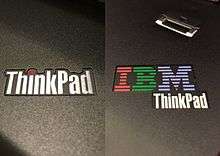
The name "ThinkPad" is a product of IBM's corporate history and culture. Thomas J. Watson, Sr., had first introduced "THINK" as an IBM slogan in the 1920s. For decades, IBM distributed small notepads with the word "THINK" emblazoned on a brown leatherette cover to customers and employees.[2] The name "ThinkPad" was suggested by IBM employee Denny Wainwright, who had a "THINK" notepad in his pocket.[3][4] The name was opposed by the IBM corporate naming committee as the names for IBM computers were all numeric at that time. "ThinkPad" was kept due to praise from journalists and the public.[5]
Early models
In April 1992, IBM announced the first ThinkPad tablet computer at a news conference. The first ThinkPad tablet, formally known as the IBM 2521 ThinkPad, was positioned as a developer's release. The ThinkPad tablet became available for purchase by the general public in October of the same year.
In addition to giving it an innovative name, IBM marketed the ThinkPad through imaginative activities such as early customer pilot programs, numerous pre-launch announcements, and an extensive loaner program designed to showcase the product's strengths and weaknesses. IBM even worked with archaeologists excavating the ancient Egyptian city of Leontopolis to field test the ThinkPad. The device was loaned to the dig team for the summer. The resulting report documented the ThinkPad's excellent performance under difficult conditions. The report said, "The ThinkPad is an impressive machine, rugged enough to be used without special care in the worst conditions Egypt has to offer."[3]
The first three ThinkPad notebook models were the 700, 700C, and 700T. They were publicly announced in October 1992.[4] The bright red TrackPoint, a kind of pointing stick embedded in the keyboard, enabled the notebook to be used on an airline tray table without a mouse. The first ThinkPads were very successful, and soon collected more than 300 awards for design and quality.[6]
Industrial design

Traditionally black, ThinkPads have commonly featured magnesium, carbon fiber reinforced plastic or titanium composite cases. The ThinkPad has introduced innovations, including the TrackPoint pointing device, the ThinkLight, a LED keyboard light at the top of the LCD screen, the Active Protection System, an accelerometer sensor which detects when a ThinkPad is falling and shuts down the hard disk drive to prevent damage, roll cage design to minimize motherboard flex, stainless steel hinges, a biometric fingerprint reader, Client Security Solution, which improves security using a built-in Trusted Platform Module (TPM) and facilitates deployment in corporate environment, the ThinkVantage Technologies suite of computer management applications, and drain holes to help reduce damage to the keyboard and components from accidental spillage.[3]
The original design concept of ThinkPad was created in 1990 by Italy-based designer Richard Sapper, a corporate design consultant of IBM and, since 2005, Lenovo.[7][8][9] Sapper is noted for the design of classic products such as the Tizio lamp for Artemide, office chair for Knoll, kitchenwares for Alessi and ballpoint for Lamy.[10][11] The design was based on the concept of a traditional Japanese Bento lunchbox revealing its nature only after being opened.[3][7][9] According to later interviews with Sapper, he also characterized the simple ThinkPad form to be as elementary as a simple, black cigar box and with similar proportions that offers a 'surprise' when opened.[10][12] These computers are also known for their iconic red joystick in the middle of the keyboard.[13]
The first ThinkPad notebook (700C) announced in 1992 was the first new product to emerge from the IBM "differentiated product personality" strategy resulting from a collaboration between Sapper and Tom Hardy, head of the corporate IBM Design Program.[7][9][14] Development of the 700C also involved a close working relationship between Sapper and Kazuhiko Yamazaki, lead notebook designer at IBM’s Yamato Design Center in Japan and liaison between Sapper and Yamato engineering.[7][14] This 1990-1992 "pre-Internet" collaboration between Italy and Japan was facilitated by a special Sony digital communications system that transmitted high-res images over telephone lines. This system was established in several key global Design Centers by Hardy so IBM designers could visually communicate more effectively and interact directly with Sapper for advice on their projects.[7][9][14] For his innovative design management leadership during ThinkPad development, Hardy was named "innovator of the Year 1992" by PC Magazine.[15] Since 1992, the ThinkPad design has been regularly updated, developed and refined over the years by Sapper[10][16] and the respective teams at IBM and later Lenovo, which included Yamazaki, Tom Takahashi, Sam Lucente and, since 1995, David Hill, Vice President of User Experience & Design, who leads and manages the design/user experience of ThinkPad.[14][17][18] Hill's approach to maintaining the evolution of Sapper's original ThinkPad design is analogous to how Porsche manages evolution of the classic 911.[3][18][19]
The fold-out butterfly keyboard, which appeared in the ThinkPad 701 series designed by Sapper in collaboration with Sam Lucente and John Karidis,[20] is widely considered a design masterpiece and is on display at the Museum of Modern Art in New York.[21] The late Dr. John Karidis invented the unique mechanism consistening of two 'triangles' that enabled the expanding keyboard function.
The ThinkPad 760 series also included an unusual keyboard design; the keyboard was elevated by two arms riding on small rails on the side of the screen, tilting the keyboard to achieve a more ergonomic design.
Although almost all models feature a trackpoint, not all models have a touchpad; of those that do, not all have left and right buttons below, possibly making mouse clicks less ergonomic. The touchpads of the X220 double as regular mouse buttons, which is also the case with some newer models (as of December 2013).[22] This can cause problems, such as accidental clicking if too much pressure is exerted during mouse movements.
On the occasion of the 20th anniversary of ThinkPad's introduction, David Hill authored and designed a commemorative book about ThinkPad design. Titled ThinkPad Design: Spirit & Essence, the book was revealed at an event held at the MoMA.
Reviews and awards
Laptop Magazine in 2006 called the ThinkPad the highest-quality laptop computer keyboard available.[23] The ThinkPad was ranked first in reliability and support in PC Magazine's 2007 Survey.[24]
The Lenovo ThinkPad was the PC Magazine 2006 Reader's Choice for PC based laptops, and ranked number 1 in Support for PC based laptops.[25] The ThinkPad Series was the first product to receive PC World's Hall of Fame award.[26]
The Enderle Group’s Rob Enderle said that the constant thing about ThinkPad is that the “brand stands for quality” and that “they build the best keyboard in the business.”[27]
The ThinkPad X Tablet-series was PC Magazine Editor's Choice for tablet PCs.[28] The 3.5 lb (1.6 kg) ThinkPad X60s was ranked number one in ultraportable laptops by PC World. It lasted 8 hours and 21 minutes on a single charge with its 8-cell battery.[29] The Lenovo ThinkPad X60s Series is on PC World's Top 100 Products of 2006.[30] The 2005 PC World Reliability and Service survey ranked ThinkPad products ahead of all other brands for reliability.[31]
In the 2004 survey, they were ranked second (behind eMachines).[32] Lenovo was named the most environment-friendly company in the electronics industry by Greenpeace in 2007[33] but has since dropped to place 14 of 17 as of October 2010.[34]
The Lenovo ThinkPad T60p received the Editor's Choice award for Mobile Graphic Workstation from PC Magazine.[35] Lenovo ThinkPad X60 is the PC Magazine Editor's Choice among ultra-portable laptops.[36]
The Lenovo ThinkPad T400-Series was on PC World's Top 100 Products of 2009.[37]
Use in space
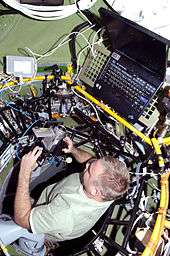


NASA purchased more than 500 ThinkPad 750 laptops for flight qualification, software development, and crew training.
Laptops used aboard the space shuttle and International Space Station feature safety and operational improvements for the weightless environment they must operate in. Modifications include velcro tape to attach to surfaces, upgrades to the CPU and video card cooling fans to accommodate for the lack of gravity (hotter air doesn't rise) and lower density of the cabin air, and an adapter to the station's 28 volt DC power.[38]
The ThinkPad 750 flew aboard the Space Shuttle Endeavour during a mission to repair the Hubble Space Telescope on December 2, 1993. The ThinkPad 750C's task was to run a NASA test program which determined if radiation inherent in the space environment causes memory anomalies in the 750C or generates other unexpected problems.[39]
Throughout 2006, a ThinkPad A31p was being used in the Service Module Central Post of the International Space Station and seven ThinkPad A31p laptops were in service in orbit aboard the International Space Station.[1] As of 2010, the Space Station was equipped with 68 ThinkPad A31 computers along with 32 new Lenovo ThinkPad T61p laptops plus a dedicated IP phone which also has limited video phone capabilities.[40] Work incorporating those laptops into the station's LAN continued into June 2011.[41] All laptops aboard the ISS are connected to the station's LAN via Wi-Fi and are connected to the ground at 3 Mbit/s up and 10 Mbit/s down, comparable to home DSL connection speeds.[40]
Acquisition by Lenovo

In 2005, Lenovo purchased the IBM personal computer business and the ThinkPad brand along with it. Speaking of the purchase of IBM's personal computer division, Liu Chuanzhi said, "We benefited in three ways from the IBM acquisition. We got the ThinkPad brand, IBM's more advanced PC manufacturing technology and the company's international resources, such as its global sales channels and operation teams. These three elements have shored up our sales revenue in the past several years."[3]
Although Lenovo acquired the right to use the IBM brand name for five years after its acquisition of IBM's personal computer business, Lenovo only used it for three years. On 7 December 2007, an event called "Lenovo Pride Day" was held. After words of encouragement from management, employees ceremoniously peeled the IBM logos off their ThinkPads and replaced them with Lenovo stickers.[3]
Manufacturing
The ThinkPad Brand shares its headquarters with Lenovo in Morrisville, North Carolina where Lenovo employs 3,500 workers. Each device made in the company’s 240,000-square-foot Guilford County facility “is packed in a box that sports a red-white-and-blue sticker proclaiming “Whitsett, North Carolina.”[27]
In 2012, Lenovo partially moved production of its ThinkPad line of computers to Japan. ThinkPads will be produced by NEC in Yonezawa, Yamagata.[42] Akaemi Watanabe, president of Lenovo Japan, said, "As a Japanese, I am glad to see the return to domestic production and the goal is to realize full-scale production as this will improve our image and make the products more acceptable to Japanese customers.”[43]
In 2014, although sales rose 5.6 percent from the previous year, Lenovo lost its position as the top commercial notebook maker.[27] However, the company will be celebrating a milestone in 2015 with the shipment of its 100 millionth unit of its ThinkPad line.[13]
Batteries
Lenovo laptops block 3rd party batteries.[44]
Recent models
ThinkPad Yoga
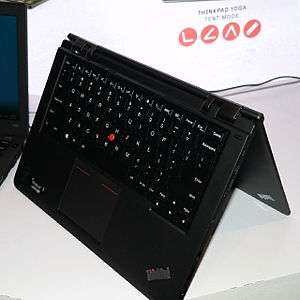
The ThinkPad Yoga is an Ultrabook-class convertible device that functions as both a laptop and tablet computer. The Yoga gets its name from the consumer-oriented IdeaPad Yoga line of computers with the same form factor. The ThinkPad Yoga has a backlit keyboard that flattens when flipped into tablet mode. This is accomplished with a platform surrounding the keys rises until level with the keyboard buttons, a locking mechanism that prevents key presses, and feet that pop out to prevent the keyboard from directly resting on flat surfaces. Lenovo implemented this design in response to complaints about its earlier Yoga 13 and 11 models being awkward to use in tablet mode. A reinforced hinge was required to implement this design. Other than its convertible form factor, the ThinkPad Yoga is a rather standard ThinkPad device with a black magnesium-reinforced chassis, island keyboard, a red TrackPoint, and a large buttonless trackpad.[45]
Yoga 14
The Yoga 14 model reportedly “strikes the middle ground between bulky workstations and flexible hybrids.”[46] The laptop’s metal hinge makes it sturdy, flexible and durable but has a below-average battery life. Like other models, the display can bend a full 180 degrees and the keyboard can be folded in half to use as a stand. According to a review for Business News Daily, “The ThinkPad Yoga 14 is a balancing act of diverse features. Thankfully, Lenovo pulled them all together into a satisfying work machine. The notebook features a high-quality build and an excellent keyboard and trackpad — all must-have features for serious productivity. And extras like the TrackPoint pointing stick are great for legacy ThinkPad users who prefer those options.”[46]
P40 Yoga
The ThinkPad P40 Yoga, like other Yoga branded products, is a convertible device with "laptop, stand, tent, and tablet" modes. The P40 Yoga includes a 2560 by 1440 pixel touchscreen display, designed in cooperation with Wacom, using that company's Active ES technology which can sense 2,048 different pressure levels. The screen works with a stylus called the ThinkPad Pen Pro that has various pen tips designed to give varied forms of tactile feedback. The P40 uses Intel Core i7 CPUs, can accommodate up to 16 gigabytes of RAM, has SSDs up to 512 gigabytes in size, and uses an Nvidia Quadro M500M GPU.[47]
Yoga 260
The Yoga 260 uses a lightweight carbon-fiber hybrid material on its lid and magnesium-plastic blend on its lower portion. Lenovo claims the Yoga 260 has been subject to extensive testing of its ability to survive extreme temperatures, vibrations, altitudes, and shocks. Its keyboard is spill resistant. It has a 13.3-inch 1080p display. An active stylus, the ThinkPad Pen Pro, is included for drawing and text entry; it can be used with Lenovo's WRITEit hand-writing recognition application. A large fingerprint reader is included for security.[48]
ThinkPad Twist
The Lenovo ThinkPad Twist is a laptop/tablet computer hybrid aimed at high-end users. The Twist gets its name from its screen's ability to twist in a manner that converts the device into a tablet. The Twist has a 12.5" screen and makes use of Intel's Core i7 processor and SSD technology in lieu of a hard drive.[49]
In a review for Engadget Dana Wollman wrote, "Lately, we feel like all of our reviews of Windows 8 convertibles end the same way. The ThinkPad Twist has plenty going for it: a bright IPS display, a good port selection, an affordable price and an unrivaled typing experience. Like ThinkPads past, it also offers some useful software features for businesses lacking dedicated IT departments. All good things, but what's a road warrior to do when the battery barely lasts four hours? Something tells us the Twist will still appeal to Lenovo loyalists, folks who trust ThinkPad's build quality and wouldn't be caught dead using any other keyboard. If you're more brand-agnostic, though, there are other Windows 8 convertibles with comfortable keyboards – not to mention, sharper screens, faster performance and longer battery life."[50]
ThinkPad Helix

The Helix is a convertible laptop satisfying both tablet and conventional notebook users. It uses a "rip and flip" design that allows the user to detach the display and then replace it facing in a different direction. It sports an 11.6" Full HD (1920 × 1080) display, with support for Windows 8 multi-touch. As all essential processing hardware is contained in the display assembly and it has multitouch capability, the detached monitor can be used as a standalone tablet computer. The Helix's high-end hardware and build quality, including Gorilla Glass, stylus-based input, and Intel vPro hardware-based security features, are designed to appeal to business users.[51]
In a review published in Forbes Jason Evangelho wrote, "The first laptop I owned was a ThinkPad T20, and the next one may very likely be the ThinkPad Helix which Lenovo unveiled at CES 2013. In a sea of touch-inspired Windows 8 hardware, it’s the first ultrabook convertible with a form factor that gets everything right. The first batch of Windows 8 ultrabooks get high marks for their inspired designs, but aren’t quite flexible enough to truly be BYOD (Bring Your Own Device) solutions. Lenovo’s own IdeaPad Yoga came close, but the sensation of feeling the keyboard underneath your fingers when transformed into tablet mode was slightly jarring. Dell‘s XPS 12 solved that problem with its clever rotating hinge design, but I wanted the ability to remove the tablet display entirely from both of those products."[52]
ThinkPad Tablet
Released in August 2011,[53] the ThinkPad Tablet is the first in Lenovo’s line of business-oriented Tablets with the ThinkPad brand. The tablet has been described by Gadget Mix as a premium business tablet.[54] Since the Tablet is primarily business-oriented, it includes features for security, such as anti-theft software, the ability to remotely disable the tablet, SD card encryption, layered data encryption, and Cisco Virtual Private Network (VPN).[55]
Additionally, the ThinkPad Tablet is able to run software such as IBM's Lotus Notes Traveler.[56] The stylus could be used to write notes on the Tablet, which also included software to convert this handwritten content to text.[56] Another feature on the Tablet was a drag-and-drop utility designed to take advantage of the Tablet's touch capabilities.[56] This feature could be used to transfer data between USB devices, internal storage, or an SD card.[56]
Slashgear summarized the ThinkPad Tablet by saying, "The stylus and the styling add up to a distinctive slate that doesn’t merely attempt to ape Apple’s iPad."[57]
ThinkPad Tablet 2

In order to celebrate the 20th anniversary of the ThinkPad, Lenovo held a large party in New York where it announced several products, including the Tablet 2. Lenovo says that the ThinkPad Tablet 2 will be available on 28 October 2012 when Windows 8 is released.[58] The ThinkPad Tablet 2 runs the Windows 8 Professional operating system. It will be able to run any desktop software compatible with this version of Windows.[58][59]
The Tablet 2 is based on the Clover Trail version of the Intel Atom processor that has been customized for tablets. The Tablet 2 has 2 gigabytes of RAM and a 64-gigabyte SSD. The Tablet 2 has a 10.1-inch IPS display with a 16:9 aspect ratio and a resolution of 1,366 by 768. In a preview, CNET wrote, "Windows 8 looked readable and functional, both in Metro and standard Windows-based interfaces." A mini-HDMI port is included for video output. An 8-megapixel rear camera and a 2-megapixel front camera are included along with a noise-canceling microphone in order to facilitate video conferencing.[58][59]
ThinkPad 8
Announced and released in January 2014, the ThinkPad 8 is based on the Intel's Bay Trail Atom Z3770 processor, with 2 GB of RAM and up to 128 GB of built-in storage. ThinkPad 8 has an 8.3-inch IPS display with a 16:10 aspect ratio and a resolution of 1920 by 1200 pixels. Other features include an aluminum chassis, micro-HDMI port, 8-megapixel back camera (with flash), and optional 4G connectivity. It runs Windows 8 as an operating system.[60]
ThinkPad 10
Announced in May 2014, Lenovo ThinkPad 10 is a successor to the ThinkPad Tablet 2 and is scheduled to launch in the summer of 2014 along with accessories such as a docking station and external detachable magnetic keyboards. It will use Windows 8.1 Pro as its operating system. It will be available in 64 and 128 GB variants with 1.6 GHz quad-core Intel Atom Baytrail processor and 2 GB or 4 GB of RAM. It will optionally support both 3G and 4G (LTE). Display resolution is announced to be 1920×1200, paired with a stylus pen.[61]
ThinkPad Yoga 11e (Chromebook version)
The ThinkPad 11e is a Chromebook that has a matte black chassis with reinforced hinges and corners, a sturdy lid, and a rubber bumper protecting its display in order to help it survive accidental dropping, spills, and general rough handling. It uses a quad-core Intel Celeron CPU, has 4 GB of RAM which can not be upgraded, an 11.6 inch screen, and 16GB or eMMC flash storage. Reviewers claim it is somewhat heavier than a typical Chromebook with a weight of 3.1 pounds. This is likely because of its ruggedized and reinforced chassis.
It uses typical ThinkPad-style keyboard with customized Chrome OS keys. It does not have Trackpoint but only a touchpad. The screen is matte with and anti-glare coating and has a resolution of 1,366 by 768 pixels. A 720p webcam is mounted above the screen. It has media card reader, a USB 2.0 port, a USB 3.0 port, and HDMI 1.4 port and a headphone jack. Connectivity is provided by 802.11ac Wi-Fi and Bluetooth 4.0.[62]
ThinkPad Yoga 11e (Windows version)
The Windows version has the same specs as the Chromebook, but comes with a 320GB hard drive for storage and also accepts SSD's. The memory can be upgraded, up to 8GB. The Windows model of the 11e is the more versatile of the two offerings from Lenovo, with upgradable hardware.
ThinkPad Stack
The ThinkPad Stack line of products includes accessories designed for portability and interoperability. This line includes external hard drives, a wireless router, a power bank, and a Bluetooth 4.0 speaker. Each Stack device includes rubber feet, magnets, and pogo-pin power connections that allow the use of a single cable. The combined weight of all the Stack devices is slightly less than two pounds. The Stack series was announced in January 2015 at the International CES.[63] The Stack series of accessories was expanded at the 2016 International CES to include a 720p resolution projector with 150 lumens of brightness and a wireless charging station.[64]
The Stack has a "blocky, black, and rectangular" look with the ThinkPad logo. It shares a common design language with ThinkPad laptop computers.[65]
P Series
The P Series line of laptops replaced Lenovo's W Series. The P Series is designed for engineers, architects, animators, etc. and comes with a variety of "high-end" options such as Intel Xeon processors and 4K screens. 1080p screens and Core Series CPUs come standard. PCIe SSDs also come standard. P Series models all included fingerprint readers. The P Series uses a cooling system known as FLEX that features two fans connected by a heat pipe and located near the CPU and GPU. A three-button touchpad is included. [66]
P50
The P50 has a 15-inch display. It supports up to three internal storage devices and has a single USB Type-C Thunderbolt 3 port. It weighs 2.54 kilograms and has a thickness of 2.59 centimeters.[66]
P70
The P70 has a 17-inch display. It weighs 3.45 kilograms and is 3.05 centimeters thick. It supports up to four internal storage devices and includes two USB Type-C Thunderbolt 3 ports.[66]
T Series
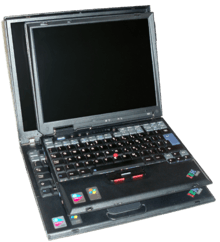
The T Series historically had high-end features, such as magnesium alloy rollcages, high-density IPS screens known as FlexView (discontinued after the T60 series), 7-row keyboards, screen latches, the Lenovo UltraBay, and ThinkLight. Models included both 14.1-inch and 15.4-inch displays available in 4:3 and 16:10 aspect ratios.
Since 2012 the entire ThinkPad line was given a complete overhaul, with modifications such as the removal of separate buttons for use with the TrackPoint, removal of separate audio control buttons, removal of screen latch, and the removal of LED indicator lights. Some of new ultra-portable models, such as T430u and T431s, have non-replaceable batteries; however, newer full-size T-series models still feature replaceable batteries. Also, non-widescreen displays are no longer available, with 16:9 aspect ratio as the only remaining choice.
W Series
The W Series was introduced in 2008 to replace the p-suffixed performance T Series (e.g. T61p), and are geared towards CAD users, photographers, power users, and others, who need a high-performance system for demanding tasks.
The W530 was released in June 2012. Minimum specifications include an Intel Core i5 (or i7) CPU, 15.6" HD screen, Nvidia Quadro K1000M graphics processor and four DIMM slots capable of accepting up to a maximum of 32 GB of RAM.
Previously available were the W7xx series (17" widescreen model), the W500 (15.4" 16:10 ratio model), the W510 (15.6" 16:9 ratio model), and W520 (15.6" 16:9 ratio model). The W700DS and the W701DS both had two displays: a 17" main LCD and a 10" slide-out secondary LCD. The W7xx series were also available with a Wacom digitizer built into the palm rest. These high-performance workstation models offer better screens and faster components, such as quad core CPUs and higher-end workstation graphics compared to the T-series, and are the most powerful ThinkPad laptops available. These retain the ThinkLight, Ultrabay, roll cage, and lid latch found on the T-series. The W7xx line has been discontinued.
X Series

The X Series is the main ultraportable ThinkPad line, offering a lightweight, highly portable laptop with moderate performance. The 12" X200-series carries all the high-end ThinkPad features like a ThinkLight, 7-row keyboard, and rollcage. The 11.6" X100e and X120e though are all plastic, lacking both the latch and the ThinkLight, and using a variant of the island keyboard (known as chiclet keyboard) found on the Edge series. The X100e was also offered in red in addition to blue, and white in some countries.[67] Those were more like high-end netbooks, whereas the X200 series were more like full ultraportables, featuring Intel i series CPUs rather than AMD netbook CPUs. The 12.5" X220 features a roll cage, Thinklight, 7-row keyboard, and an optional premium IPS display, the first IPS display on a ThinkPad since the T60p. However, it lacks lid latch (which the previous X201 and X200 had). A 13.3" thin and light line was offered (the X300/X301), though it has been discontinued. A slim 12" line (X201s) with low voltage CPUs and high resolution displays was also offered, though they were also discontinued.
The X Series tablet is a variant of the 12" X Series models, with low voltage CPUs and a flip-screen tablet screen. These include the traditional ThinkPad features, and have been noted for using a higher quality AFFS-type screen with better viewing angles compared to the screens used on other ThinkPads. A 12.5" X220T model is available.
ThinkPad X1 Tablet
The ThinkPad X1 Tablet is a modular device that uses what Lenovo calls an "Ultra Connect" system to tie together a removable modules such as an extra battery pack, a pico projector, a 3D camera, a detachable keyboard, etc. The X1 Tablet is powered by an Intel Core m7 processor paired with up to 16 gigabytes of memory and solid state drives up to 1 terabyte in size. The X1 Tablet's 12-inch multitouch screen is 2,160 pixels by 1,440 pixels.[64]
ThinkPad X100e
The ThinkPad X100e is an entry-level ultraportable notebook. The X100e is available in standard non-glossy black, red, or white outer cases. It contains unusual features like the presence of three USB 2.0 ports, VGA port, Ethernet LAN port, 4-in-1 card reader, headphone and mic combo jack. Features an AMD Athlon Neo X2 Single-Core MV-40 (1.60 GHz, 512 KB) CPU, support for up to 4 GB 667 MHz DDR2 memory. It comes with ATI Radeon HD 3200 IGP 128 MB graphic cards, 11.6in HD AntiGlare (1,366 × 768-pixels) display and six-cell lithium-ion. Unlike most ThinkPads, it uses the chiclet keyboard of the ThinkPad Edge series.
ThinkPad X120e
The ThinkPad X120e is an entry-level ultraportable notebook. It is available in black to consumers and white, black, and red in certain markets. It contained the same ports as the x100e except for an added HDMI port. It features either the AMD Fusion E240 (1.5 GHz single-core) or E350 (1.6 GHz dual-core) CPUs (both of which are Zacate), along with integrated Radeon 6310 graphics. AMD calls this configuration an APU, or Accelerated Processing Unit. It also supports 4 GB of DDR3 1333 MHz memory, though many users have reported that it actually supports 16 GB (2x 8GB s0 pc3-8500 1066Mhz). It also uses the new chiclet keyboard design like the x100e and ThinkPad Edge.
ThinkPad X130e
A special edition laptop was provided for Australian Year 9 students as part of the Digital Education Revolution (DER) program in 2012.
Hardware Specifications:
- Intel Celeron processor 857, dual-core 1.2 GHz
- 4 GB Memory
- 320 GB HDD
- 11.6" HD (1366 × 768)
- Integrated 0.3MP camera
- Integrated Bluetooth
- Weight: 1.78 kg with 6-cell battery
- 2 years warranty.
ThinkPad X131e Chromebook
The X131e is a Chrome OS powered laptop designed for the education market. It has a durable case fitted with rubber bumpers in order to improve its durability. The X131e's 11.6-inch display has a resolution of 1366 by 768 pixels and has an anti-glare coating. It can be customised with various colors, school logos, and asset tagging.[68]
ThinkPad X60 Series
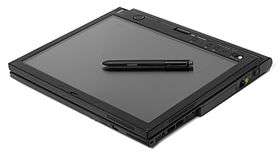
Includes the X60 and X61, with their associated s and Tablet series. The X60 is the first X-Series ThinkPad to feature Intel chips using the Intel Core architecture. The Core Duo L2400 (Low Voltage) CPU on the X60s model achieves 7+ hours of battery life on standard benchmarks, and can reach around 10 hours under light use, when using the extended-life battery. This model lacks a built-in optical drive, unlike the larger T60. The X61, like the T61, also is the first X-series ThinkPad to use Intel's Santa Rosa platform and to be available with a 3G WWAN option. This series includes the ThinkPad Reserve Edition, a 5,000-model limited edition laptop designed for executive class professionals. It was clad in hand-stitched leather, and came with a three-year 24/7 service warranty.
ThinkPad X300/X301
Codenamed "Kodachi", with X300 released on 26 February 2008. Distinguished from other ultraportable laptops by its usage of LED backlighting, removable battery, solid-state drive, and integrated DVD burner, it is the flagship model for the X-series. The ThinkPad X300 used a small form factor Intel GS965 chipset, instead of standard GM965 chipset, along with Intel Core 2 Duo L7100 low-voltage CPU with only 12 W TDP. Its successor, the ThinkPad X301 uses the Intel Centrino 2 mobile platform with GS45 chipset, and an ultra-low-voltage (ULV) CPU. It also integrates GPS, WWAN, and a webcam in the top lid. The thickest part of the laptop is 0.92 in (2.3 cm), while the thinnest part is 0.73 in (1.9 cm).
The X300's original internal codename was Razor, after the then popular flip phone from Motorola. Lenovo noticed that three technologies were converging that would make it possible to build a very thin, light, and fast ThinkPad. The first was solid-state storage, which would replace mechanical hard drives. The second was light-emitting diode (LED) backlighting for flat-panel displays which would improve battery life and image quality. The third was ultrathin optical drives just 7 mm thick, compared to 9.5 mm to 12.7 mm on other ThinkPads. The Razor concept was eventually merged with the Bento-Fly project and renamed Kodachi.
ThinkPad X200/X200s, X201/X201s, X220, X230, X240, X250

Successor to the X60-series, the ThinkPad X200 laptop leverages the new technology from the X300, including the options of a solid-state drive (SSD), an optional integrated camera, 12.1" widescreen display, optional 3G WWAN, a new 9-cell battery for extended running time up to 9.8 hours, weight as low as 2.95 lb (1.34 kg), and CPU up to 2.66 GHz Intel Core 2 Duo. The X200s is a newer model of the X200 which is lighter and thinner, and has the option of a WXGA+ screen with LED Backlighting for increased battery performance. The X200 series included Tablet PC models, designated by the usage of the "t" suffix.[69]
ThinkPad X1

An addition to the lightweight X series, weighing between 1.36 kg to 1.72 kg depending on configuration. It was the thinnest ThinkPad laptop to date at 16.5 (front) and 21.5 mm (rear). The screen is a 13.3-inch (340 mm) LED-backlit HD infinity panel with 1366 × 768 (WXGA) resolution. Base configuration uses an Intel Sandy Bridge 2.5 GHz Core i5-2520M (up to 3.20 GHz) with 4 GB of RAM (up to 8 GB), SATA or SSD hard drive, Intel Integrated HD Graphics, USB 3.0, backlit keyboard, 802.11 b/g/n WiFi and an average of eight hours of battery life. The battery is internal and not removable, and there is no optical drive. A 13.3" X1 ThinkPad was announced to be available in the UK on June 7, 2011.
ThinkPad X1 Carbon

The X1 Carbon features a solid-state drive (SSD) instead of a hard drive. The base model has 4 gigabytes of memory, an Intel Core i5-3317U processor, and a 128-gigabyte SSD. The most expensive model has an Intel Core i7 processor and a 256-gigabyte SSD. The X1 Carbon requires the use of a dongle to access wired Ethernet and some models include 3G cellular modems.[70]
The X1 Carbon has a 14-inch screen with a resolution of 1600 by 900 pixels. The X1 Carbon weighs 1.36 kilograms (3.0 lb) and measures 13.03 by 8.9 by 0.74 inches (331 by 226 by 19 mm). The X1 Carbon's case is made of light carbon-fiber and has a matte black finish.[70] The Carbon is also marketed “as the thinnest 14” ultrabook.”[13]
In a review published for CNET, Dan Ackerman wrote, "At first glance, the ThinkPad X1 Carbon looks a lot like other ThinkPads, but in the hand it stands out as very light and portable. The excellent keyboard shows up other ultrabooks, and the rugged build quality is reassuring. With a slightly boosted battery and maybe a lower starting price, this could be a serious contender for my all-around favorite thin laptop."[71]
In November 2012, Lenovo announced a touch-screen variant called the ThinkPad X1 Carbon Touch designed for use with Windows 8. Its display makes use of multi-touch technology that can detect simultaneous inputs from up to ten fingers.[72] On the performance of the X1 Carbon Touch's SSD, Engadget states, "The machine boots into the [s]tart screen in 11 seconds, which is pretty typical for a Windows 8 machine with specs like these. We also found that the solid-state drive delivers equally strong read and write speeds (551 MB/s and 518 MB/s, respectively), which we noticed the last time we tested an Ultrabook with an Intel SSD."
L Series
The L Series replaced the former R Series, and is positioned as a mid-range ThinkPad offering with second generation Core i3/i5/i7 CPUs. The L Series as launched had two models, the 14" L412 and the 15.6" L512. In March 2011, Lenovo revamped the series to launch the 14" L420/L421 and the 15" L520/L521.
S Series
The S Series is positioned as a mid-range ThinkPad offering, containing ultrabooks derived from the Edge Series. As of August 2013, the S Series includes S531 and S440 models; their cases are made of aluminum and magnesium alloy, available in silver and gunmetal colors.[22]
Edge Series
The Edge Series was released early in 2010 as small business and consumer-end machines. The design was a radical departure compared to the traditional black boxy ThinkPad design, with glossy surfaces (optional matte finish on later models), rounded corners, and silver trim. They were also offered in red, a first for the traditionally black ThinkPads. Like the SL, this series was targeted towards small businesses and consumers, and lack the roll cage, Ultrabay, lid latch, and ThinkLight of traditional ThinkPads (though the 2011 E220s and E420s had ThinkLights).[73] This also introduced an island-style keyboard with a significantly different layout.
Models included 12.5"(E220, E220s) 13.3" (Edge 13), 14"(Edge 14, E420, E420s), and 15.6" (Edge 15, E520, E545[74]) sizes. An 11.6" Edge 11 model was offered, but not available in the United States.[75]
Discontinued models
ThinkPad Reserve Edition
This model was initially known inside of Lenovo as the "Scout." This was the name of the horse ridden by Tonto, the sidekick from the 1950s television series The Lone Ranger. Lenovo envisioned the Scout as a very high-end ThinkPad that would be analogous to a luxury car. Each unit was covered in fine leather embossed with its owners initials. Extensive market research was conducted on how consumers would perceive this form factor. It was determined that they appreciated that it emphasised warmth, nature, and human relations over technology. The Scout was soon renamed the ThinkPad Reserve Edition. It came bundled with premium services including a dedicated 24-hour technical support hotline that would be answered immediately. It was released in 2007 and sold for $5,000 in the United States.[76][77]
ThinkPad 235
The Japan-only ThinkPad 235 (or Type 2607), was the progeny of the IBM/Ricoh RIOS project. Also known as Clavius or Chandra2, it contains unusual features like the presence of three PCMCIA slots and the use of dual camcorder batteries as a source of power. Features an Intel Pentium MMX 233 MHz CPU, support for up to 160 MB of EDO memory, and a built-in 2.5 in (64 mm) hard drive with UDMA support. Hitachi marketed Chandra2 as the Prius Note 210.
ThinkPad 240
The ultraportable ThinkPad 240 (X, Z) started with an Intel Celeron processor and went up to the 600 MHz Intel Pentium III. In models using the Intel 440BX chipset, the RAM was expandable to 320 MB max with a BIOS update. With a 10.4 in (260 mm) screen and an 18 mm (0.71 in) key pitch (a standard key pitch is 19 mm (0.75 in)). They were also one of the first ThinkPad series to contain a built-in Mini PCI card slot (form factor 3b). The 240s have no optical disc drives and an external floppy drive. An optional extended battery sticks out the bottom like a bar and props up the back of the laptop. Weighing in at 2.9 lb (1.3 kg), these were the smallest and lightest ThinkPads ever made.
300 Series
The 300-series (300, 310, 340, 350, 360, 365, 380, 385, 390 (all with various sub-series)) was a long-running value series starting at the 386SL/25 processor, all the way to the Pentium III 450. The 300 series was offered as a slightly lower-price alternative from the 700 series,[78] with a few exceptions.
The ThinkPad 360PE was a unique model in the series in that it could be used as a regular laptop, or transform into a tablet by flipping the monitor on top of itself. Retailing for $3,699 in 1995, the 360PE featured a touch sensitive monitor that operated with the stylus; the machine could run operating systems that supported the touch screen such as PenDOS 2.2.[79]
-
An IBM ThinkPad 310ED and a 760ED, both from the 1996-97 era. The 760ED boasts the unique flip-up keyboard that was standard on all 760 ThinkPads
-
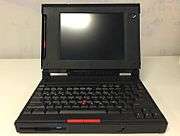
The 360PE opened in its 'natural' mode
-

The 360PE in mid-fold showing how the monitor rotates over the unit
-

The 360PE folded in its 'tablet' mode allowing the laptop to be held as a tablet would
-

The 360PE's keyboard opens up on hinges for easy serviceability
500 Series
The 500-series (500, 510, 560 (E, X, Z), 570 (E)) were the main line of the ultraportable ThinkPads. Starting with the 486SLC2-50 Blue Lightning to the Pentium III 500, these machines had only a hard disk on board. Any other drives were external (or in the 570's case in the UltraBase). They weighed in at around 4 lb (1.8 kg).
600 Series
The 600-series (600, 600E, and 600X) are the direct predecessors of the T series. The 600-series packed a 12.1 in (310 mm) SVGA or a 13.3 in (340 mm) XGA TFT LCD, Pentium MMX, Pentium II or III processor, full-sized keyboard, and optical bay into a package weighing roughly 5 lb (2.3 kg). IBM was able to create this light, fully featured machine by using lightweight but strong carbon fiber composite plastics. The battery shipped with some 600-series models had a manufacturing defect that left it vulnerable to memory effect and resulted in poor battery life, but this problem can be avoided by use of a third-party battery.
700 Series
The 700 Series (700, 701, 720, 730 (tablet), 750, 755, 760, 765, 770 with various sub-models) were once considered cutting-edge Intel-based ThinkPads. They featured the best screens, largest hard drives and fastest processors available at the time. This was the first successful ThinkPad introduced in 1992 (the first ThinkPad was a tablet PC without a keyboard and a mouse).
800 Series

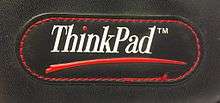
The ThinkPad 800 Series (800/820/821/822/823/850/851/860) were unique as they were based on the PowerPC architecture rather than the Intel x86 architecture. Most of the 800 Series laptops used the PowerPC 603e CPU, at speeds of 100 MHz, or 166 MHz in the 860 model, although the earliest 800 (Type 6020), the direct ancestor of the 850, used a 603 and was apparently only offered to developers.[80] All units used SCSI-2 instead of IDE hard disks, and the ID of every SCSI device on the system could be configured in the cursor driven GUI-based BIOS. Another unusual aspect of the series is their unique startup chime, reminiscent of Apple Macintosh computers of the time.
The PowerPC ThinkPad line was considerably more expensive than the standard x86 ThinkPads -- even a modestly configured 850 cost upwards of $12,000.[81] On the other hand, the 800, 850 and 851 (and later the 860 and 861) were capable of supporting an optional web camera, one of the first commercially available webcams available on a laptop.[82] These units could also record PAL and NTSC signals with onboard composite connectors, and the batteries contained internal processors to regular power usage for optimized battery longevity.[83]
All of the PowerPC ThinkPads could run Windows NT 3.5 and 4.0,[84] OS/2 Warp Connect PowerPC Edition, AIX 4.1.x, and Solaris Desktop 2.5.1 PowerPC Edition. Many of these PowerPC operating systems and the corresponding compilers are very scarce and hard to find. However, it is also possible to run certain PowerPC versions of Linux on the 800 Series.[85]
| 800 | 820 | 821/822/823 | 850 | 851 | 860 | |
|---|---|---|---|---|---|---|
| System Type | 6020 | 6040 | 7247 | 6042 | 7249 | 7249 |
| Announced | 1994/08/11[80] | 1995/06/19 | 1996/02/20 | 1995/06/19 | 1996/02/20 | 1996/10/08 |
| Withdrawn | ??? | 1996/03/20 | 1996/07/26 | 1996/03/20 | 1996/11/08 | 1998/01/30 |
| CPU | 603 @ 66 MHz | 603e @ 100 MHz | 603e @ 100 MHz | 603e @ 100 MHz | 603e @ 100 MHz | 603e @ 166 MHz |
| GPU | GT10 | GT10 | GT10 | GT10 | GT10 | GT20 |
| Memory Bus | 32-bit | 32-bit | 32-bit | 64-bit | 64-bit | 64-bit |
| Maximum Memory | 80 MB | 48 MB | 48 MB | 96 MB | 96 MB | 96 MB |
| LCD and Resolution | 10.4" @ 640x480 | 10.4" @ 640x480 or 800x600 | 10.4" @ 640x480 or 800x600 | 10.4" @ 640x480 or 800x600 | 10.4" @ 640x480 or 800x600 | 12.1" @ 1024x768 |
| Video Capture | built-in | optional | optional | built-in | built-in | built-in |
Z Series
The Z series was released as a high-end multimedia laptop; as a result this was the first ThinkPad to feature a widescreen (16:10 aspect ratio) display.[86][87] The Z-Series was also unique in that certain models featured an (optional) titanium lid.[88] Integrated WWAN and a webcam were also found on some configurations. The series has only ever included the Z60 (Z60m and Z60t) and Z61 (Z61m, Z61t and Z61p); the latter of which is the first Z-Series ThinkPad with Intel "Yonah" Dual Core Technology. The processor supports Intel VT-x; this is disabled in the BIOS but can be turned on with a BIOS update. Running fully virtualised operating systems via Xen or VMware is therefore possible.[89] Despite the Z61 carrying the same number as the T61, the hardware of the Z61 is closer to a T60 (and likewise the Z60 being closer to a T43).
-
The Z61 featuring a titanium lid (note the duality of colors)
-
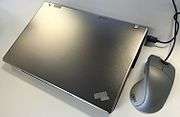
The ThinkPad Z61t accompanied by a silver ScrollPoint Pro
-

The ThinkPad Z61t opened showing the internal keyboard
SL Series
The SL Series was launched in 2008 as a low-end ThinkPad targeted mainly geared toward small businesses.[90] These lacked several traditional ThinkPad features, such as the ThinkLight, magnesium alloy roll cage, Ultrabay, and lid latch, and use a 6-row keyboard with a different layout than the traditional 7-row ThinkPad keyboard. Models offered included 14" (SL400 and SL410) and 15.6" (SL500 and SL510). A 13.3" model (SL300) was previously offered, but discontinued.
A Series
The A-series was developed as an all-around productivity machine, equipped with hardware powerful enough to make it a desktop replacement. Hence it was the biggest and heaviest ThinkPad series at its time, but also had features not even found in a T-series of the same age. The A-series was dropped in favor of the G-series and R-series.
The A31 was released in 2002 as a desktop replacement system equipped with: A Pentium 4-M processor clocked at 1.6, 1.8, 1.9, or 2.0 GHz (max supported is a 2.6 GHz), An ATI Mobility Radeon 7500, 128 or 256 MB of PC2100 RAM (officially upgradable to 1 GB but can be unofficially upgraded to 2 GB), IBM High Rate Wireless (PRISM 2.5 Based, can be modified to support WPA-TKIP) and equipped with a 20, 30, or 40 GB hard disk drive.
G Series
The G-series consisted of only three models, the G40, G41 and G50. Being large and heavy machines, equipped with powerful desktop processors, this line of ThinkPads was consequently served mainly as replacements for desktop computers.
R Series
The R Series was a budget line beginning with the R30 in 2002 and ending with the R500 in 2008.
-
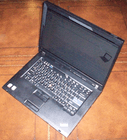
Lenovo ThinkPad R500
-
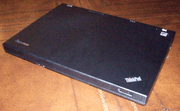
Lenovo ThinkPad R500 (lid closed)
-
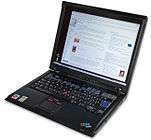
IBM ThinkPad R51
-
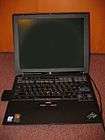
IBM ThinkPad R32
i Series
The ThinkPad i Series was introduced by IBM in 1999 and was geared towards a multimedia focus with many models featuring independent integrated CD players and multimedia access buttons.[91] The 1400 and 1500 models were designed by Acer for IBM under contract and featured similar hardware found in Acer laptops (including ALi chipsets, three way audio jacks and the internal plastics painted with a copper paint).[92] Some of the i Series ThinkPads, particularly the Acer developed models, are prone to broken hinges and stress damage on the chassis.
One notable ThinkPad in the i Series lineup are the S3x (S30/S31) models: featuring a unique keyboard and lid design allowing a standard size keyboard to fit in a chassis that otherwise wouldn't be able to support the protruding keyboard. These models were largely only available in Asia Pacific. IBM offered an optional piano black lid on these models (designed by the Yamato Design lab).[93] This is the only ThinkPad since the 701C to feature a special design to accommodate a keyboard that's physically larger than the laptop and also the only ThinkPad (aside from the Z61) to deviate away from the standard matte lid.
-
The ThinkPad S31 with the piano black finish option sitting on top of a Z61t: both ThinkPads deviate from the usual matte black
-
The S31 with the lid open showing the unique protruding keyboard, no touchpad was offered to keep the laptop compact
-
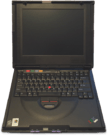
An IBM ThinkPad 1400 i Series with the integrated CD-Player and customizable multimedia access buttons
See also
References
- 1 2 "IBM ThinkPads in space". IBM. 1993-12-02. Archived from the original on 2011-07-20. Retrieved May 12, 2008.
- ↑ "The History of the ThinkPad Name".
- 1 2 3 4 5 6 7 Hamm, Steve (2008). The Race for Perfect – Inside the Quest To Design the Ultimate Portable Computer' '. New York City: McGraw-Hill.
- 1 2 "IBM Highlights, 1990 -1995" (PDF). IBM. December 2001. Retrieved May 11, 2008.
- ↑ Thinkpads.com, "How did the ThinkPad get its name?" (title appears here). Archived from the original on 2007-09-22.
- ↑ "IBM Archives: 1992". IBM. Retrieved May 12, 2008.
- 1 2 3 4 5 Sakakibara, K., “IBM ThinkPad 700C Notebook Computer Case″, Centre for Design Management - London Business School, 1994.
- ↑ Golden, Peter "Big Blue's big adventure". EDN Network. January 1999.
- 1 2 3 4 Hardy, Tom (1998). "Design Saves The Brand". Academia.edu.
- 1 2 3 Webb, M., (2002), Richard Sapper, San Francisco: Chronicle Books, 2002.
- ↑ Hamm, Steve, ″Richard Sapper: Fifty years at the Drawing Board″, Business Week, January 9, 2008.
- ↑ "Richard Sapper and the Lenovo ThinkPad X300". Lenovovideolibrary.com. 2008-02-26.
- 1 2 3 Yin, Dave (2015-02-13). "100 million later: A look back at ThinkPad". Computer Dealer News. Retrieved 2015-02-2015. Check date values in:
|access-date=(help) - 1 2 3 4 Dell, D.; Purdy, G., ThinkPad: A Different Shade of Blue. Indianapolis: Sams/Mcmillan, 1999.
- ↑ "25 Years of PC Magazine: Year Eleven/1992". PC Magazine.
- ↑ "Richard Sapper Industrial Designer". North Carolina State University.
- ↑ "David Hill: Richard Sapper". Lenovoblogs.com. 2006-07-13.
- 1 2 "David Hill: ThinkPad Spirit & Essence". Lenovoblogs.com. 2012-10-05.
- ↑ NOTCOT (April 29, 2010). "Porsche 911 Evolution".
- ↑ "MoMA The Collection: Richard Sapper, Sam Lucente, Robert Tennant and IBM Corporation, Think Pad 701 Portable Computer, 1995". The Museum of Modern Art. 2010-09-30.
- ↑ "Lenovo ThinkPad Tablet 2, X1 Carbon Debut at MoMA Anniversary Bash - Desktops and Notebooks - News & Reviews - eWeek.com".
- 1 2 Tobias Winkler (2013-08-30). "Review Lenovo ThinkPad S440 Touch Ultrabook". notebookcheck.net. Retrieved 2013-12-24.
- ↑ Bsales, Jamie (2006). Lenovo "Lenovo ThinkPad T60: Light business notebook with performance to spare" Check
|url= - ↑ "Is Tech Support Getting Worse? - Notebooks - Reviews by PC Magazine". Pcmag.com. 2007-09-13. Retrieved 2012-04-22.
- ↑ "The 19th Annual Reader Satisfaction Survey - Readers' Choice: Notebooks Survey - News and Analysis by PC Magazine". Pcmag.com. 2006-08-21. Retrieved 2012-04-22.
- ↑ "Best of 2004". PC World. 2004-06-02. Retrieved 2012-04-22.
- 1 2 3 Ranii, David (2015-02-04). "After 100 million sold, Lenovo’s ThinkPad laptop still going strong". The News & Observer. Retrieved 2015-03-10.
- ↑ Buying Guide: Business Laptops - Lenovo ThinkPad X60 Tablet - Reviews by PC Magazine
- ↑ Lenovo ThinkPad X60s Review, by Dan Sommer May 2, 2006 (2006-05-02). "Lenovo ThinkPad X60s Review". PC World. Retrieved 2012-04-22.
- ↑ "The 100 Best Products of 2006". PC World. 2006-05-31. Retrieved 2012-04-22.
- ↑ Bertolucci, Jeff (2005-12-01). "Reliability and Service: The Best Companies to Buy From". PC World. Retrieved 2012-04-22.
- ↑ McLaughlin, Laurianne (2004-12-01). "Reliability and Service: Readers Rate the Manufacturers". PC World. Retrieved 2012-04-22.
- ↑ Feature story - April 3, 2007 (2007-04-03). "Chinese company tops Greenpeace "Green Ranking" of electronics industry | Greenpeace International". Greenpeace.org. Retrieved 2012-04-22.
- ↑ How the companies line up | Greenpeace International Archived January 27, 2007 at the Wayback Machine
- ↑ "Lenovo ThinkPad T60p - Reviews by PC Magazine". Pcmag.com. 2007-02-23. Retrieved 2012-04-22.
- ↑ "Lightning-Fast Surfing, To Go - Lenovo ThinkPad X60 (Vista) - Reviews by PC Magazine". Pcmag.com. 2007-02-07. Retrieved 2012-04-22.
- ↑ World, The PC (2009-10-26). "The PC World 100: Best Products of 2009". Pcworld.com. Retrieved 2012-04-22.
- ↑ 2001: A Space Laptop, By Keith Cowing, Posted:September 18, 2000, SpaceRef
- ↑ "IBM Archives: 1993". IBM. Retrieved May 12, 2008.
- 1 2 Bilton, Nick (January 22, 2010). "First Tweet From Space". Bits (blog of The New York Times). Retrieved January 22, 2010.
- ↑ "2011-06-07 Daily ISS Report". NASA.
- ↑ "Lenovo celebrates ThinkPad laptop 20th anniversary by producing special edition in Japan". The Japan Daily Press.
- ↑ Constantin Murariu (5 July 2012). "Lenovo Moves ThinkPad Production Back to Japan". Softpedia. Retrieved 12 July 2012.
- ↑ Sean Hollister (16 March 2012). "Lenovo laptops will reject third-party batteries, starting with ThinkPad Edge in May?". The Verge. Vox Media.
- ↑ Dan Ackerman (5 September). "Hands-on with Lenovo's ThinkPad Yoga". CNET. Retrieved 4 October 2013. Check date values in:
|date=(help) - 1 2 Nuckles, Brett (2015-02-28). "Lenovo ThinkPad Yoga 14: It’s Good for Business". Business News Daily. Retrieved 2015-05-10.
- ↑ Bell, Lee (2 December 2015). "Lenovo ThinkPad P40 Yoga: Mobile workstation takes aim at creative professionals". The Inquirer (United Kingdom). Retrieved 6 December 2015.
- ↑
- ↑ James Stables. "Lenovo ThinkPad Twist review". TechRadar.
- ↑ "Lenovo ThinkPad Twist review: an old form factor gets new life with Windows 8". Engadget. AOL.
- ↑ Matt Smith (7 January 2013). "Lenovo announces ThinkPad Helix and IdeaPad Yoga 11S convertibles". Digital Trends.
- ↑ Jason Evangelho. "Best Of CES: Is Lenovo's ThinkPad Helix The Perfect Ultrabook/Tablet Hybrid?". Forbes.
- ↑ Joseph Volpe (29 July 2011). "Lenovo ThinkPad Tablet gets an August 23rd release". Retrieved 11 November 2011.
- ↑ Paul Merak (20 July 2011). "Lenovo ThinkPad Tablet overview". Retrieved 11 November 2011.
- ↑ Ross Catanzariti (21 July 2011). "Lenovo ThinkPad Tablet preview: Lenovo brings its corporate-looking design to the tablet market". Retrieved 11 November 2011.
- 1 2 3 4 Agam Shah (20 July 2011). "Lenovo Announces ThinkPad Tablet for Businesses". Retrieved 11 November 2011.
- ↑ Vincent Nguyen (19 July 2011). "Lenovo IdeaPad K1 and ThinkPad Tablet hands-on". Retrieved 11 November 2011.
- 1 2 3 Editors (10 August 2012). "Lenovo ThinkPad Tablet 2". Retrieved 121 August 2012. Check date values in:
|access-date=(help) - 1 2 Andrew Cunningham (9 August 2012). "Lenovo unveils new Atom-powered ThinkPad Tablet 2 with Windows 8". Ars Technica.
- ↑ "Lenovo intros the ThinkPad 8, an 8-inch Windows tablet for business users (hands-on)". engadget.com. 2014-01-05. Retrieved 2014-01-07.
- ↑ Dan Ackerman (31 October 2014). "Lenovo ThinkPad 10 review - CNET". CNET. CBS Interactive.
- ↑ Delaney, John R. (15 August 2015). "Lenovo ThinkPad 11e Chromebook". PC Magazine (Asia). Retrieved 4 September 2015.
- ↑ Sanders, James (13 October 2015). "ThinkPad Stack Professional Kit delivers on interoperability and portability, disappoints on speed". Tech Republic (United States). Retrieved 7 November 2015.
- 1 2 Gabe Carey (3 January 2016). "These are Lenovo's First 2016 ThinkPads - CES 2016 - Page 2 - Digital Trends". Digital Trends.
- ↑ Andrew E. Freedman. "Lenovo Thinkpad Stack - Full Review and Benchmarks".
- 1 2 3 Avram Piltch, LAPTOP Online Editorial Director. "Crazy Powerful: Lenovo ThinkPad P First with Xeon CPU".
- ↑ White Thinkpad X100e unboxed, January 6th, 2010, Cloned In China
- ↑ Chris Burns (2014-04-07). "Lenovo ThinkPad X131e Chromebook made available to Schools". SlashGear. Retrieved 2014-04-16.
- ↑ "Lenovo ThinkPad X200 Tablet (Multitouch)". Pcmag.com. 2009-09-30. Retrieved 2012-04-22.
- 1 2 Larry Magid (14 August 2012). "Magid on Tech: Lenovo's new X1 Carbon a top-notch ultrabook". Mercury News. Retrieved 15 August 2012.
- ↑ Dan Ackerman (8 August 2012). "Lenovo ThinkPad X1 Carbon". CNET. Retrieved 15 August 2012.
- ↑ Chris Welch (2012-11-20). "Lenovo website reveals ThinkPad X1 Carbon Touch ultrabook for Windows 8". The Verge. Retrieved 2013-09-28.
- ↑ Hobbes, John (January 3, 2011). "Lenovo Announces Premium ThinkPad Edge E220s, E420s SMB Notebooks". Thinkpads.com web site. Retrieved June 3, 2011.
- ↑ "Lenovo Thinkpad Edge E545 Review". Gaming Laptop. Retrieved 2015-02-23.
- ↑ Stern, Joanna (September 28, 2010). "Lenovo ThinkPad Edge 11 announced with Intel and AMD options, denied US citizenship". Engadget.com web site. Retrieved June 3, 2011.
- ↑ Miller, Paul (2007-06-15). "ThinkPad Reserve Edition unveiled". Engadget.com. Retrieved 2014-05-07.
- ↑ Dillet, Romain (2007-09-05). "ThinkPad Reserve Edition". TechCrunch. Retrieved 2014-05-07.
- ↑ "ThinkPad series".
- ↑ "Pen Computing historic reviews: IBM ThinkPad 360PE (1995)".
- 1 2 "IBM Power Series Exotica".
- ↑ Cordes, Trevor E. (24 July 2008). "IBM PowerPC ThinkPad Hisotry". Retrieved 1 June 2014.
- ↑ http://ps-2.kev009.com/aixtp/Brochure/4249-860.pdf
- ↑ "IBM PowerPC ThinkPad Capabilities".
- ↑ "Windows NT on PowerPC ThinkPad". YouTube. 2010-01-08. Retrieved 2013-09-28.
- ↑ "Debian -- PowerPC Port".
- ↑ Harald Thon (27 March 2006). "Is Lenovo's Widescreen Z60m the First Thinkpad Multimedia Powerhouse?". Tom's Guide.
- ↑ "TFT display".
- ↑ "Lenovo ThinkPad Z60t Review (pics, specs)". NotebookReview.com.
- ↑ Hamm, Steve (2008-02-13). "Building the Perfect Laptop". Businessweek.com. Retrieved 2014-08-27.
- ↑ "ThinkPad SL Series". Inside the Box lenovo Blog. July 25, 2008. Retrieved May 31, 2011.
- ↑ "IBM News room - 1999-06-08 New ThinkPad i Series Notebook PCs Double as Mobile Entertainment Centers - United States".
- ↑ "Category:I Series".
- ↑ ThinkPadStyle. "ThinkPad FC - News - Rumours - Leaks - Reviews".
External links
| Wikimedia Commons has media related to ThinkPad. |
- thisisthinkpad.com, This Is ThinkPad (Lenovo's official ThinkPad website)
- ThinkPad models on ThinkWiki
- Lenovo ThinkPad T430s manual
| |||||||||||||||||||||||||||||||||||||||||||||||||||||||